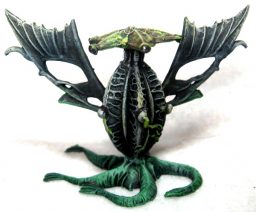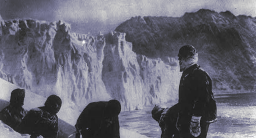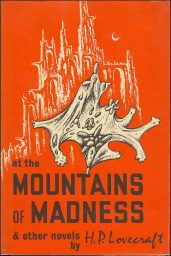The 2016 H. P. Lovecraft Re-read: At the Mountains of Madness
Sunday , 9, October 2016 Fiction 8 Comments “At the Mountains of Madness” is H. P. Lovecraft’s third longest work coming in at 40,881 words. He wrote it from February 24 to March 22, 1931 (Joshi, H. P. Lovecraft: A Life).
“At the Mountains of Madness” is H. P. Lovecraft’s third longest work coming in at 40,881 words. He wrote it from February 24 to March 22, 1931 (Joshi, H. P. Lovecraft: A Life).
I read 1/3 of the short novel 33 years ago but bogged down and scanned through portions of the rest. I think I switched over to reading Fritz Leiber’s Fafhrd & the Gray Mouser stories.
This time I made it all the way through pacing myself through the week reading two chapters a day.
The story is about an expedition to Antarctica by Miskatonic University. Chapter 1 is devoted to the organizing of the expedition and the trip to Antarctica. Chapter 2 has the narrator telling about radio transmissions from on a group whose plane is forced down by weather. They end up boring the ice and discover a cave full of skeletal fragments and fossils. In the course of transmissions, a strange discovery is made of “monstrous” barrel shaped fossils. Eight feet long, 3.5 feet diameter. Seven foot wings present in furrows. Five sets of tentacles at the equator. Five-pointed starfish shaped head covered with three-inch wiry cilia. Eyes present at the end of each point on the head. The base has five “arms” with a paddle at the end.”
Eight perfect specimens are later found. A strong storm cuts off communication with the base camp. A party sets out in the remaining airplane to reach the outpost camp. They find everything destroyed, the dogs dead, eleven humans dead and one missing. The narrator and Danforth search for the missing Gedney.
The duo fly into a mountain range finding a plateau at 20,000 feet above sea level. They also find what appears to be ruins of a city.
Chapter 5 is a description of the incredibly ancient city (50 million years) and exploration of the buildings. Chapter 7 is info-dump. The Old ones are aliens who colonize Earth, first in the sea. They also create earth-life. Our existence is due to the Old Ones presence on Earth.
Lovecraft mentions wars with other aliens such as the Cthulhu spawn and the fungoid crustacean Mi-Go. There are also wars with rebelling Shoggoths, protoplasmic creatures created as slave labor to build the cities.
Lovecraft also mentions Robert E. Howard’s Valusia and Clark Ashton Smith’s Commorium and Hyperborea.
There are mentions of The Necronomicon, Wilmarth from “The Whisperer in Darkness,” and other Mythos items. Also the painter Nicholas Roerich is mentioned more  than needed.
than needed.
There is a classic, no doubt inadvertently funny line:
“Radiates, vegetables, monstrosities, star-spawn–whatever they had been, they were men!”
The duo run into six foot, white, blind penguins and also find the missing Gedney and a dog, preserved. Lake’s party had brought the eight intact specimens out of hibernation. The Old Ones had fought back and taken some specimens of their own back to their city.
“Scientists to the last–what had they done that we wound not have done in their place? God, what intelligence and persistence!”
The two find decapitated Old Ones and soon find the Shoggoths are guilty of the crime. The make their escape from a Shoggoth.
“The nightmare plastic column of foetid black iridescence oozed tightly onward through its fifteen-foot sinus…a shapeless congeries of protoplasmic bubbles, faintly self-luminous, and with myriads of temporary eyes forming and unforming as pustules of greenish light all over the tunnel-filling front that bore down upon us.”
And there you have it, 40,000+ words. Farnsworth Wright at Weird Tales rejected it that was “too long,” “not easily divisible into parts,” “not convincing.” Lovecraft would not do anything with a story once rejected. Wright could have worked with Lovecraft suggesting cuts and revisions.
The story easily could have been cut 10,000 words. There are problems– the story is not horrific. Lovecraft was getting over fond of his creations and they were losing their scare quality. I have given thought as to what could have been done with the story. One is make two stories, the first with the emphasis on the reviving aliens wiping out Lake’s camp. There could have been a sequel story with the finding of the Shoggoth in the dead city. The sections with the info-dump could have been condensed as quick back ground.
The story eventually sold to Astounding Stories in 1936. F. Orlin Tremaine, editor at Astounding Stories who had no problem poaching writers from Weird Tales exasperated by Farnsworth Wright’s consistent capriciousness. “At the Mountains of Madness” was broken up into three parts.
The end result of Wright’s rejection is Lovecraft was pretty much done with Weird Tales. A few more stories would appear but there are Lovecraft stories never written due to Wright.

A friend of mine once said to me that he considered Lovecraft to be not so much horror but “really down science fiction.” Lovecraft just could not quite make a clean break with gothic window dressing like the obligatory mention of Abdul Alhazred and The Necronomicon.
Reader reaction to “At the Mountains of Madness” in Astounding Stories was mixed with some hostility to Lovecraft’s presence.
If you want to read a really great polar horror story, read John W. Campbell’s “Who Goes There?” Campbell was a non-fan of Lovecraft but you wonder if he wrote the story in reaction to “At the Mountains of Madness.”
I just can’t get real excited over the story. I didn’t finish it the first time and not particularly looking forward to plowing my way through it the past week. Another example of Lovecraft’s ideas better than the execution.

Proof – as if proof was ever needed – that Lovecraft was the William McGonagall of the weird.
“They end up boring the ice” – HPL in a nutshell.
Again, brilliant world building and mediocre to poor storytelling. This story and the less well known (although I believe better-written) “The Shadow Out Of Time” form the basis for what I like to call The Eldritch Earth–an alternate paleo-history of the human race being the inheritors of a world that was heavily colonized and terraformed millions of years ago.
I wonder sometimes if Lovecraft’s clunky prose and tin ear for timing contributed to the rise of “Lovecraftian” as a genre. Reading his stories one tends to think not only, “what an interesting premise” but also “pity it’s so poorly executed–I bet I could do better.”
I would love to see an account of the Parbodie exhibition written by someone with a feel for wilderness survival. Lovecraft missed so much of the tension that could have been provided by the storm and the isolation and spent way too long on the philosophical musings of his narrator.
When I read this story a few years ago all I could think of was John Carpenter’s “The Thing”
The setting, Antarctica, and the weird gruesome shapes that the “Thing” took are the obvious reasons why.
No idea if “At the Mountains of Madness” was a direct influence on the film though.
-
“No idea if “At the Mountains of Madness” was a direct influence on the film though.”
Update: I looked it up watching a making of “The Thing” video. It is based on John W. Campbell’s “Who Goes There?”
…and JWC’s “Who Goes There?” was inspired by AtMoM. In turn, AtMoM was a kind of sequel to Poe’s “The Narrative of Arthur Gordon Pym”.
Postscript: John Carpenter is a huge fan of HPL.
And yet AtMoM remains an iconic story of the genre.
It is true that it misses its mark and could have been much better with tighter editing and making the environment more of the menace.
It is curious that despite his ability to so clearly establish mood and setting he rarely ever made much use of it after the initial introduction.
I am a big fan of HPL but I feel he is at his best in short works. Yet even there his difficulty with bringing stories to a satisfying conclusion often robbed them of impact.
In his longer works his over-fondness with his own vocabulary gets in the way and often overshadows the story itself.
Not only does Lovecraft lose his way with the info-dump, turning his monsters into all too humanized, sympatheic creatures, but the ending of the story is extremely rushed and confusing, and even after multiple re-reads, I still scratch my head trying to figure out exactly what happened with “poor Danforth.”
In spite of it’s crippling flaws, it’s a fascinating story, but its one you almost have to read between the lines of what was ACTUALLY written.